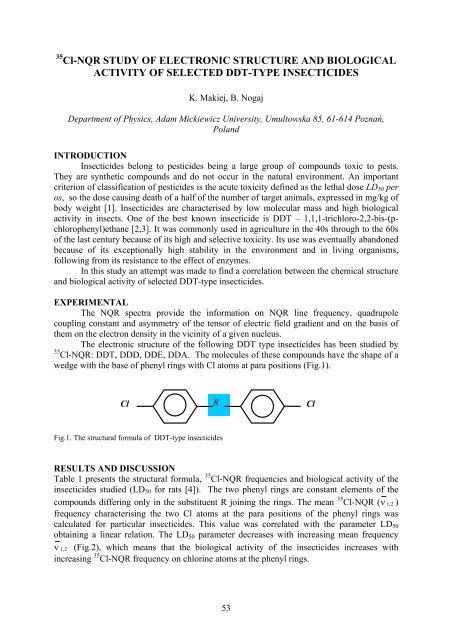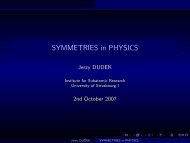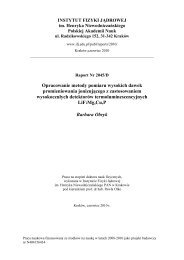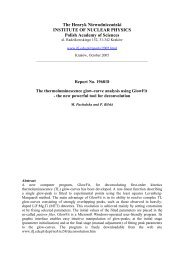Report No xxxx - Instytut Fizyki JÄ drowej PAN
Report No xxxx - Instytut Fizyki JÄ drowej PAN
Report No xxxx - Instytut Fizyki JÄ drowej PAN
Create successful ePaper yourself
Turn your PDF publications into a flip-book with our unique Google optimized e-Paper software.
35 Cl-NQR STUDY OF ELECTRONIC STRUCTURE AND BIOLOGICAL<br />
ACTIVITY OF SELECTED DDT-TYPE INSECTICIDES<br />
K. Makiej, B. <strong>No</strong>gaj<br />
Department of Physics, Adam Mickiewicz University, Umultowska 85, 61-614 Poznań,<br />
Poland<br />
INTRODUCTION<br />
Insecticides belong to pesticides being a large group of compounds toxic to pests.<br />
They are synthetic compounds and do not occur in the natural environment. An important<br />
criterion of classification of pesticides is the acute toxicity defined as the lethal dose LD 50 per<br />
os, so the dose causing death of a half of the number of target animals, expressed in mg/kg of<br />
body weight [1]. Insecticides are characterised by low molecular mass and high biological<br />
activity in insects. One of the best known insecticide is DDT – 1,1,1-trichloro-2,2-bis-(pchlorophenyl)ethane<br />
[2,3]. It was commonly used in agriculture in the 40s through to the 60s<br />
of the last century because of its high and selective toxicity. Its use was eventually abandoned<br />
because of its exceptionally high stability in the environment and in living organisms,<br />
following from its resistance to the effect of enzymes.<br />
In this study an attempt was made to find a correlation between the chemical structure<br />
and biological activity of selected DDT-type insecticides.<br />
EXPERIMENTAL<br />
The NQR spectra provide the information on NQR line frequency, quadrupole<br />
coupling constant and asymmetry of the tensor of electric field gradient and on the basis of<br />
them on the electron density in the vicinity of a given nucleus.<br />
The electronic structure of the following DDT type insecticides has been studied by<br />
35 Cl-NQR: DDT, DDD, DDE, DDA. The molecules of these compounds have the shape of a<br />
wedge with the base of phenyl rings with Cl atoms at para positions (Fig.1).<br />
Cl<br />
R<br />
Cl<br />
Fig.1. The structural formula of DDT-type insecticides<br />
RESULTS AND DISCUSSION<br />
Table 1 presents the structural formula, 35 Cl-NQR frequencies and biological activity of the<br />
insecticides studied (LD 50 for rats [4]). The two phenyl rings are constant elements of the<br />
compounds differing only in the substituent R joining the rings. The mean 35 Cl-NQR ( ν 1, 2 )<br />
frequency characterising the two Cl atoms at the para positions of the phenyl rings was<br />
calculated for particular insecticides. This value was correlated with the parameter LD 50<br />
obtaining a linear relation. The LD 50 parameter decreases with increasing mean frequency<br />
ν 1,2 (Fig.2), which means that the biological activity of the insecticides increases with<br />
increasing 35 Cl-NQR frequency on chlorine atoms at the phenyl rings.<br />
53

















